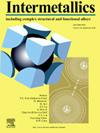铸态AlCoCrFeNi2.1与GH4169的电子束焊接:异种接头的组织演变与力学性能
IF 4.8
2区 材料科学
Q2 CHEMISTRY, PHYSICAL
引用次数: 0
摘要
成功地制备了铸态AlCoCrFeNi2.1共晶高熵合金与GH4169高温合金之间的声电子束焊接接头。随后系统地研究了束流(Ib)和焊接速度(v)对AlCoCrFeNi2.1/GH4169异种电子束接头组织演变和力学性能的影响。在24 mA电流、12 mm/s焊接速度、114.0 J/mm热输入的焊接参数下,合金的抗拉强度为878.3 MPa,断裂应变为27.4%,获得了最佳力学性能。低热输入接头(Q <;114.0 J/mm),表现出缺乏渗透和不完全融合等缺陷,导致承载能力降低。反之,过高的热输入(Q >;114.0 J/mm)会引发熔合区脆性Laves相的过度沉淀,从而降低接头强度。随着热输入的增加,熔合区的平均晶粒尺寸从32.8 μm增加到38.1 μm。AlCoCrFeNi2.1共晶高熵合金的硬度最高(~ 307HV),超过了熔合区(260 ~ 289hv)和GH4169区(~ 225HV)。本文章由计算机程序翻译,如有差异,请以英文原文为准。
Electron beam welding of as-cast AlCoCrFeNi2.1 and GH4169: microstructural evolution and mechanical performances of dissimilar joints
Sound electron beam welded joints were successfully fabricated between as-cast AlCoCrFeNi2.1 eutectic high-entropy alloy and GH4169 superalloy. A systematic investigation was subsequently conducted into the influence of beam current (Ib) and welding speed (v) on the microstructure evolution and mechanical properties of the AlCoCrFeNi2.1/GH4169 dissimilar electron beam joints. The optimal mechanical performance was achieved with an ultimate tensile strength of 878.3 MPa and a fracture strain of 27.4 %, under welding parameters of a 24 mA beam current, 12 mm/s welding speed, and a heat input of 114.0 J/mm. In joints with low heat input (Q < 114.0 J/mm), defects such as lack of penetration and incomplete fusion were exhibited, leading to a reduction in load-bearing capacity. Conversely, an excessively high heat input (Q > 114.0 J/mm) has been shown to triggers over-precipitation of brittle Laves phase in the fusion zone, thereby reducing the joint strength. The mean grain size in the fusion zone exhibited an increase from 32.8 μm to 38.1 μm in conjunction with an escalation in the applied heat input. The AlCoCrFeNi2.1 eutectic high-entropy alloy demonstrated the highest degree of hardness (∼307HV), exceeding both the fusion zone (260-289HV) and the GH4169 zone (∼225HV).
求助全文
通过发布文献求助,成功后即可免费获取论文全文。
去求助
来源期刊

Intermetallics
工程技术-材料科学:综合
CiteScore
7.80
自引率
9.10%
发文量
291
审稿时长
37 days
期刊介绍:
This journal is a platform for publishing innovative research and overviews for advancing our understanding of the structure, property, and functionality of complex metallic alloys, including intermetallics, metallic glasses, and high entropy alloys.
The journal reports the science and engineering of metallic materials in the following aspects:
Theories and experiments which address the relationship between property and structure in all length scales.
Physical modeling and numerical simulations which provide a comprehensive understanding of experimental observations.
Stimulated methodologies to characterize the structure and chemistry of materials that correlate the properties.
Technological applications resulting from the understanding of property-structure relationship in materials.
Novel and cutting-edge results warranting rapid communication.
The journal also publishes special issues on selected topics and overviews by invitation only.
 求助内容:
求助内容: 应助结果提醒方式:
应助结果提醒方式:


